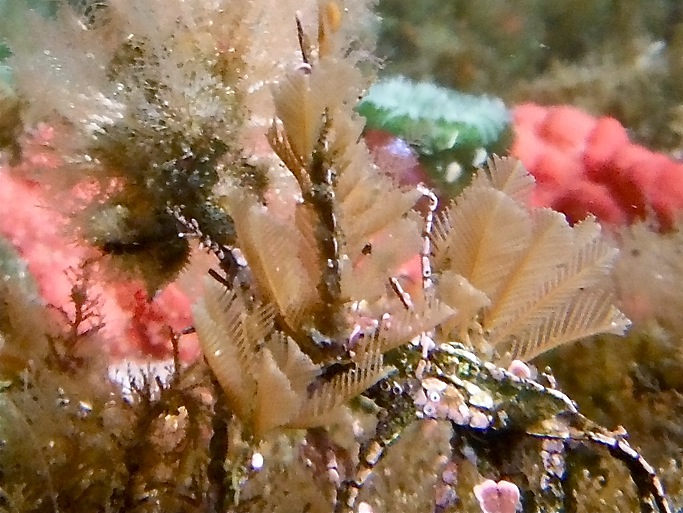Ostrich-plume hydroid • Aglaophenia sp.
Identification
Ostrich-plume hydroids, of which there are at least six species, are colonial animals that form feather-like plumes. Individual polyps are tiny and when open only extend towards the top sides of the colony's branches (photo). Larger pod-shaped structures (corbulae) appear in rows along some branches (photo). Ostrich-plume hydroids grow to 15 cm tall. The species in this genus are difficult to differentiate, partially because those species in the Pacific Northwest require further systematic work. Two of the more well-known species are Aglaophenia struthionides and A. latirostris.
Habitat & Range
Ostrich-plume hydroids attach to substrates in rocky subtidal areas to a depth of 160 m. Areas with currents are preferred. These species are found from Alaksa to northern Mexico.
iNaturalist
https://www.inaturalist.org/taxa/51218-Aglaophenia
Ostrich-plume hydroids, of which there are at least six species, are colonial animals that form feather-like plumes. Individual polyps are tiny and when open only extend towards the top sides of the colony's branches (photo). Larger pod-shaped structures (corbulae) appear in rows along some branches (photo). Ostrich-plume hydroids grow to 15 cm tall. The species in this genus are difficult to differentiate, partially because those species in the Pacific Northwest require further systematic work. Two of the more well-known species are Aglaophenia struthionides and A. latirostris.
Habitat & Range
Ostrich-plume hydroids attach to substrates in rocky subtidal areas to a depth of 160 m. Areas with currents are preferred. These species are found from Alaksa to northern Mexico.
iNaturalist
https://www.inaturalist.org/taxa/51218-Aglaophenia
References
Cowles, D. (2006). Aglaophenia sp. (probably latirostris or struthionides). Invertebrates of the Salish Sea. Rosario Beach Marine Laboratory. Accessed 02/02/2015.
Lamb, A., and Hanby, B. (2005). Marine Life of the Pacific Northwest [electronic version]. Madeira Park, BC: Harbour Publishing.
Authors and editors of page
Bridget Woods, Kelly Fretwell, and Brian Starzomski (2015).
Cowles, D. (2006). Aglaophenia sp. (probably latirostris or struthionides). Invertebrates of the Salish Sea. Rosario Beach Marine Laboratory. Accessed 02/02/2015.
Lamb, A., and Hanby, B. (2005). Marine Life of the Pacific Northwest [electronic version]. Madeira Park, BC: Harbour Publishing.
Authors and editors of page
Bridget Woods, Kelly Fretwell, and Brian Starzomski (2015).





